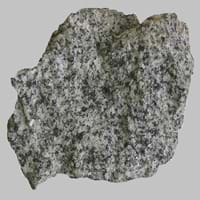Siltstone and Diorite
Definition
Definition
Siltstone can be defined as a fine-grained sedimentary rock which mainly consists of consolidated silt
Diorite is a grey to dark-grey intermediate intrusive igneous rock composed principally of plagioclase feldspar,biotite, hornblende, and pyroxene
History
Discoverer
Unknown
Unknown
Etymology
From English word silt and stone and from Proto-Indo-European root sal and stainaz
From early 19th century coined in French, formed irregularly from Greek diorizein distinguish
Class
Sedimentary Rocks
Igneous Rocks
Sub-Class
Durable Rock, Hard Rock
Durable Rock, Hard Rock
Family
Group
Not Applicable
Plutonic
Other Categories
Fine Grained Rock, Opaque Rock
Coarse Grained Rock, Medium Grained Rock, Opaque Rock
Texture
Texture
Clastic
Phaneritic
Color
Brown, Red, Reddish Brown
Black, Brown, Light to Dark Grey, White
Maintenance
Less
Less
Durability
Durable
Durable
Water Resistant
Yes
No
Scratch Resistant
Yes
No
Stain Resistant
No
No
Wind Resistant
Yes
Yes
Acid Resistant
Yes
No
Appearance
Rough
Shiny
Uses
Architecture
Interior Uses
Decorative Aggregates, Interior Decoration
Decorative Aggregates, Interior Decoration
Exterior Uses
As Building Stone, As Facing Stone, Garden Decoration
As Building Stone, As Facing Stone, Garden Decoration
Other Architectural Uses
Curbing
Curbing
Industry
Construction Industry
Building houses or walls, Cement Manufacture, Construction Aggregate, for Road Aggregate, Making natural cement, Raw material for the manufacture of mortar
As Dimension Stone, Cement Manufacture, Cobblestones, Construction Aggregate, for Road Aggregate
Medical Industry
Not Yet Used
Not Yet Used
Antiquity Uses
Artifacts, Sculpture, Small Figurines
Artifacts, Monuments, Sculpture, Small Figurines
Other Uses
Commercial Uses
Raw material for the manufacture of mortar, Soil Conditioner
Creating Artwork, Curling
Types
Types
Not Available
Not Available
Features
Available in Lots of Colors and Patterns, Easily splits into thin plates, Generally rough to touch, High silica content, Very fine grained rock
Typically speckled black and white.
Archaeological Significance
Monuments
Not Yet Used
Used
Famous Monuments
Not Applicable
Data Not Available
Sculpture
Used
Used
Famous Sculptures
Data Not Available
Data Not Available
Pictographs
Not Used
Not Used
Petroglyphs
Not Used
Not Used
Figurines
Used
Used
Fossils
Present
Absent
Formation
Formation
Siltstone is a type of sedimentary rock which is formed from fine rock particles. As the particles of eroded rock travel along with water, the edges of the rock are worn-out by water into a rounded shape.
Diorite is a coarse-grained intrusive igneous rock which contains large interlocking and randomly oriented crystals and forms when molten lava does not reach the Earth’s surface and cools down in the Earth’s crust.
Composition
Mineral Content
Calcite, Clay, Clay Minerals, Feldspar, Micas, Quartz, Sand, Silica, Silt
Albite, Amphibole, Apatite, Biotite, Feldspar, Hornblade, Ilmenite, Magnetite, Muscovite or Illite, Olivine, Plagioclase, Pyroxene, Quartz, Sulfides, Titanite, Zircon
Compound Content
Aluminium Oxide, CaO, Iron(III) Oxide, Potassium Oxide, MgO, Sodium Oxide, Silicon Dioxide
Silicon Dioxide
Transformation
Metamorphism
No
Yes
Types of Metamorphism
Not Applicable
Cataclastic Metamorphism, Contact Metamorphism, Regional Metamorphism
Weathering
Yes
Yes
Types of Weathering
Biological Weathering, Chemical Weathering, Mechanical Weathering
Biological Weathering, Chemical Weathering, Mechanical Weathering
Erosion
Yes
Yes
Types of Erosion
Chemical Erosion, Coastal Erosion, Glacier Erosion
Chemical Erosion, Coastal Erosion, Water Erosion
Properties
Physical Properties
Hardness
6-7
6-7
Grain Size
Fine Grained
Medium to Coarse Grained
Fracture
Conchoidal
Not Available
Streak
White
Bluish Black
Porosity
Highly Porous
Very Less Porous
Luster
Dull
Shiny
Compressive Strength
Not Available
225.00 N/mm2
7
Cleavage
Not Available
Not Available
Toughness
2.6
2.1
Specific Gravity
2.54-2.73
2.8-3
Transparency
Opaque
Opaque
Density
2.6-2.7 g/cm3
2.8-3 g/cm3
Thermal Properties
Resistance
Heat Resistant, Impact Resistant, Pressure Resistant, Water Resistant
Heat Resistant, Pressure Resistant, Wear Resistant
Reserves
Deposits in Eastern Continents
Asia
China, India, Kazakhstan, Mongolia, Russia, Uzbekistan
Not Yet Found
Africa
Namibia, Nigeria, South Africa
Egypt
Europe
Austria, Denmark, Germany, Great Britain, Netherlands, Norway, Poland, Sweden, Switzerland, United Kingdom
Finland, Germany, Italy, Romania, Sweden, Turkey, United Kingdom
Others
Greenland
Not Yet Found
Deposits in Western Continents
North America
Canada, USA
USA
South America
Brazil
Argentina, Bolivia, Chile, Colombia, Ecuador, Peru
Deposits in Oceania Continent
Australia
New South Wales, New Zealand
New Zealand, Western Australia
All about Siltstone and Diorite Properties
Know all about Siltstone and Diorite properties here. All properties of rocks are important as they define the type of rock and its application. Siltstone belongs to Sedimentary Rocks while Diorite belongs to Igneous Rocks.Texture of Siltstone is Clastic whereas that of Diorite is Phaneritic. Siltstone appears Rough and Diorite appears Shiny. The luster of Siltstone is dull while that of Diorite is shiny. Siltstone is available in brown, red, reddish brown colors whereas Diorite is available in black, brown, light to dark grey, white colors. The commercial uses of Siltstone are raw material for the manufacture of mortar, soil conditioner and that of Diorite are creating artwork, curling.
|
||
|
||
|










